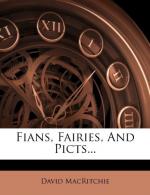[Footnote 82: Skene’s Celtic Scotland, vol. iii. pp. 106-7.]
[Footnote 83: Class H. 3, 17, Trinity College, Dublin. [I quote from Mr. Petrie’s “Round Towers,” Trans, of Roy. Irish Acad., vol. xx. (Dublin, 1845), p. 98.]]
[Footnote 84: Rath Chruachain, Co. Roscommon: the cemetery was styled Relig na Riogh, or the Cemetery of Kings.]
[Footnote 85: Op. cit., p. 106.]
[Footnote 86: “Is in Brug, or Bruig.” Mr. Petrie invariably translates this as “at” Brugh. But I observe that Dr. Standish O’Grady (Silva Gadelica, p. 256; and p. 289 of English translation) renders the Gaelic particle by English “in.” To decide between two Gaelic scholars is not within my province. But if Dr. O’Grady understands “the Brugh” to be synonymous with Sidh an Bhrogha (as perhaps he does not), the adoption of his reading would lead to an inference which is opposed to common sense.]
[Footnote 87: Molyneux, writing in 1725, says that “when first the cave was opened, the bones of two dead bodies entire, not burnt, were found upon the floor.” Colonel Forbes Leslie remarks: “Llhuyd, the antiquary, writing in 1699, makes no mention of any human remains being found in it.”]
[Footnote 88: Since the above was written, the quarterly number, June 1893, of the Journal of the Royal Society of Antiquaries of Ireland has been issued, and a note therein confirms the suspicion, indicated in Mr. Wakeman’s drawing, that the whole mound is not yet explored. But the above remarks are applicable in any case.]
[Footnote 89: Petrie: op. cit., p. 106.]
[Footnote 90: That is, Lughaidh of the Red Stripes; “meaning that on his person he had two such: one as girdle round his middle, another as necklace round his neck.” (Silva Gadelica, English translation, p. 544.)]
[Footnote 91: Petrie (op. cit., p. 101), quoting from the “History of the Cemeteries” in the Leabhar na h-Uidhre.]
[Footnote 92: These two extracts are from Silva Gadelica, Eng. transl., pp. 495 and 544; where the references are, respectively, “Book of Ballymote, 250 a b,” and “Kilbride No. 3, Advocates’ Library, Edinburgh, 5.”]
[Illustration: PLATES XX. AND XXI.
SECTIONAL VIEW AND GROUND PLAN OF THE DENGHOOG, ISLAND OF SYLT.]
[Illustration: PLATE XXII.
INTERIOR OF THE DENGHOOG, ISLAND OF SYLT.]
PLATES XX. AND XXI.—The Denghoog,
Island of Sylt, North
Friesland.
In addition to my original collection, I am now able to show three views of the Denghoog, in Sylt, which is the mound referred to on p. 34 (ante). Mr. W.G. Black speaks of it thus:—




